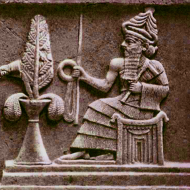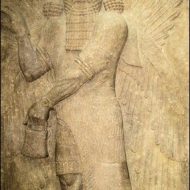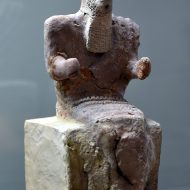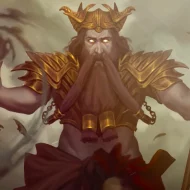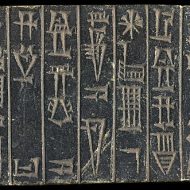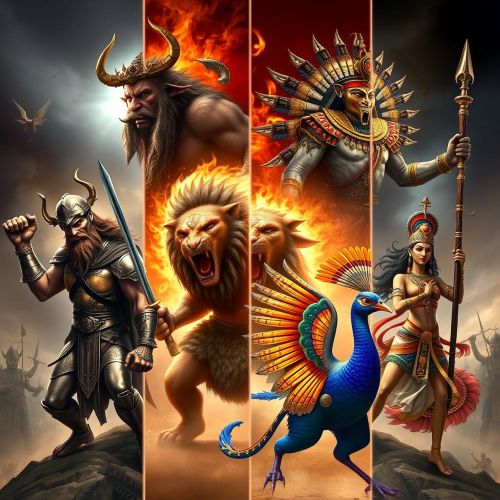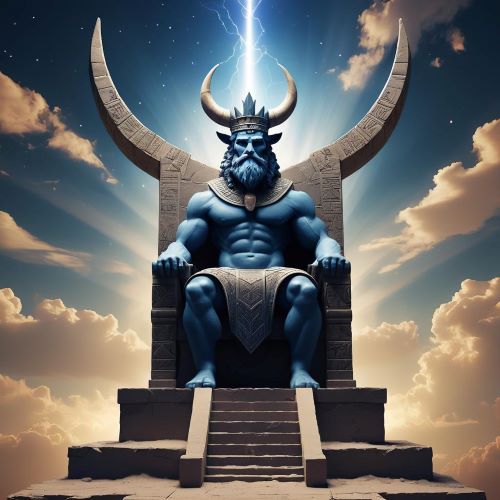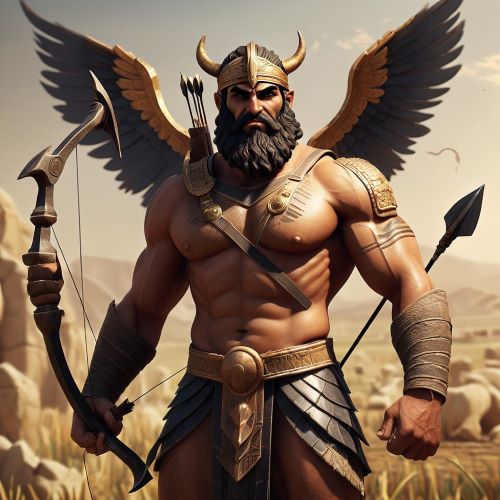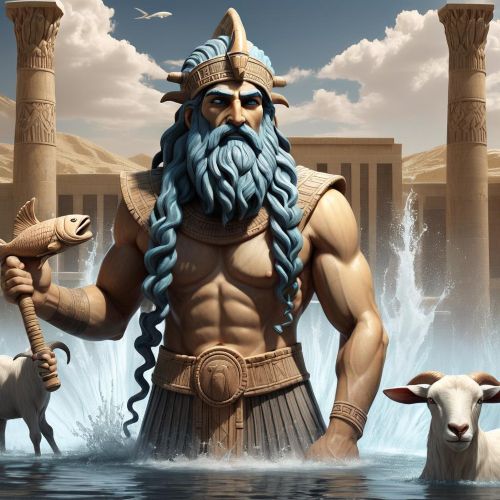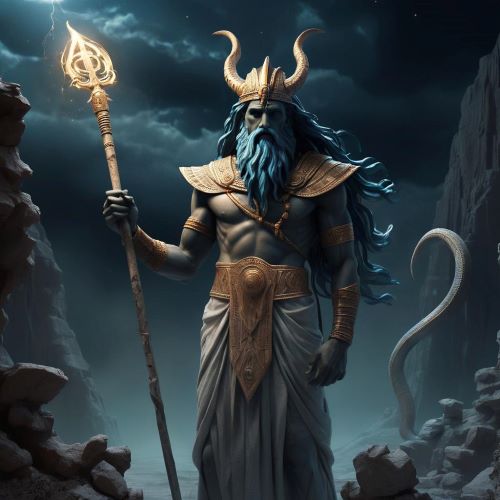Enlil : The King of Gods
Listen
At a glance
| Description | |
|---|---|
| Origin | Middle Eastern Mythology |
| Classification | Gods |
| Family Members | Nanna (Son), Inanna (Granddaughter), Ninlil (Wife) |
| Region | Iraq, Syrian, Turkey |
| Associated With | Weather, Floods, Air, Hurricanes, Agriculture |
Enlil
Introduction
Enlil, a central figure in Mesopotamian mythology, forms part of a triad of gods alongside Ea and An. Referred to as the “Lord of the Air,” Enlil’s influence is felt in the gentle spring breezes and the powerful hurricanes that sweep across cities, said to be the very breath through which he issues commands. While An held the title of the highest god in the Sumerian hierarchy, Enlil’s importance surpassed that of his father, becoming known as the god of agriculture and the founder of Nippur. Legend has it that Enlil played a pivotal role in the creation of agricultural tools, particularly the hoe, by separating Earth from heaven to create fertile ground for seeds. Another tale recounts his imprisonment and subsequent demise after impregnating Ninlil, a grain goddess—a story reflective of the agricultural cycle, echoing themes of winter dormancy, fertilization, and harvest.
Marduk later assumed leadership of the Babylonian Pantheon, replacing Enlil, yet the latter retained his status as the principal deity of Nippur. His significance persisted well into the 2nd millennium BC, illustrating his enduring importance in Mesopotamian religious practices. Enlil, whose name translates to “Lord Wind,” holds a towering position among Mesopotamian deities. Worshipped by Sumerians, Akkadians, Babylonians, and Assyrians alike, his influence transcended time, shaping their perspectives on the universe, agriculture, and the concept of destiny. Enlil’s domain extended beyond meteorological phenomena, encompassing realms of kingship, justice, and the fates of gods and mortals. Also known as Elil and Ellil, Enlil’s sanctity was centered at the Ekur temple in Nippur, serving as a focal point for devotion and cultural identity across ancient Mesopotamia.
Physical Traits
Enlil, a prominent figure in Babylonian art and literature, is often depicted wearing a horned cap adorned with seven superimposed ox-horns—a symbol of divinity that dates back to the third millennium BC. This distinctive headgear remained consistent in form and significance throughout Sumerian prehistory and persisted until the conquest of the Persian Empire. Enlil’s physical appearance, however, remains somewhat mysterious compared to the well-defined physiques of Greek or Roman deities. Descriptions suggest an image of immense power and majesty, radiating such intensity that even other gods could not gaze directly upon him. While specific details about his physique are scarce, Enlil is often associated with the powerful wind, which might be represented in depictions with flowing robes or windswept hair.
In Babylonian art, Enlil is commonly portrayed as a bearded deity of great stature, exuding power and wisdom. His regal demeanor symbolizes his dominion over the heavens and the earth. Enlil’s appearance underscores his role as a divine force, commanding the very elements he governs—the wind ruffling his robes, clouds swirling around him, and lightning illuminating his presence. These depictions capture the essence of Enlil’s authority and reflect the reverence with which he was regarded by ancient Mesopotamian cultures. The imagery conveys Enlil’s profound connection to natural forces, emphasizing his role as the Lord of the Air and a principal deity in the Sumerian pantheon.
Throughout Mesopotamian art and literature, Enlil’s portrayal highlights his divine attributes and significance within the celestial hierarchy. His depiction with the horned cap signifies his status as a god of immense power and authority, a figure who transcends mortal understanding. Enlil’s physical representation in Babylonian art serves as a visual testament to his role in shaping the cosmos and influencing the destinies of gods and humans alike, making him a central figure in the pantheon of Mesopotamian deities.
Family
Enlil, a central deity in Babylonian mythology, holds familial ties that reflect the intricate web of Mesopotamian pantheon relationships. Traditionally considered the son of Anu, the sky god, and Ki, the earth goddess, Enlil embodies the union of fundamental natural forces. His siblings include Enki (Ea), the god of wisdom and fresh water, with whom Enlil engages in mythological narratives shaping cosmic events and human destinies. Enlil’s role as a father figure is prominent, with offspring including the moon god Nanna (Sin) and the powerful goddess of war and love, Inanna (Ishtar), solidifying his lineage within the divine hierarchy.
Enlil’s primary consort was Ninlil, also known as Sud, the grain and fertility goddess. Their union, depicted with complexity and sometimes conflict, bore significant offspring, including Ninurta, Nanna, Nergal, Ninazu, and Enbilulu. These divine relationships underscore Enlil’s role as a progenitor of influential deities within Mesopotamian cosmology. The diversity in Enlil’s parentage and lineage reflects the multifaceted nature of Mesopotamian mythos, shaped over centuries by diverse cultures and interpretations.
In various Mesopotamian texts, Enlil’s parentage is occasionally depicted differently, attributing him as the child of Enki (Ea) and Ninki. This variation underscores the fluidity and adaptability of mythological narratives within Mesopotamian traditions, where gods were adopted and reinterpreted across cultures and historical epochs. The contradictions and adaptations in Enlil’s lineage highlight the dynamic nature of ancient belief systems, where different scribes and cultures retold tales to suit their specific contexts and religious practices.
Other Names
Enlil, was revered under various names and epithets throughout history, reflecting his multifaceted roles and attributes. In Sumerian tradition, he was known as “Ellil” or “Bel” (Lord), emphasizing his supreme authority among the gods. Akkadian texts referred to him as “Ilu,” denoting divine beings of great power and status. Enlil’s influence transcended linguistic boundaries, with alternative names like Nunamnir in literary texts and Illinos in Greek highlighting his significance across different cultures and eras. These variations underscore the fluidity of divine nomenclature in ancient Mesopotamia, where deities were worshipped under diverse titles in various regions.
The evolution of Enlil’s name throughout history further illustrates the dynamic nature of Mesopotamian religious traditions. The Akkadians referred to him as Ellil, while the Assyrians used the form Elil. Enlil was also associated with the epithet Nunamnir, suggesting his lordship over the earth. These nuanced variations in naming reflect the complex interplay between mythological narratives and regional beliefs, highlighting how divine identities adapted and transformed over time within Mesopotamian cultures.
Enlil’s name derives from ancient Sumerian components—EN, meaning “lord,” and LÍL, which carries debated meanings. The diverse epithets and linguistic adaptations associated with Enlil underscore his enduring importance and influence within Mesopotamian religious and cultural contexts. As a deity of supreme authority and cosmic significance, Enlil’s name embodies the rich tapestry of ancient mythological traditions, resonating across civilizations and enduring through millennia.
Powers and Abilities
Enlil, originally associated with the city of Nippur, rose to prominence among the Babylonian gods, alongside An and Enki. Known for wielding the Tablets of Destiny, Enlil possessed great authority over the universe and humanity. While he could exhibit kindness, Enlil was also characterized as stern and harsh, reflecting his dominion over natural phenomena such as storms, winds, and the life-giving breath of the universe. As the god of weather, Enlil could unleash devastating tempests or bring gentle rains upon the earth, influencing agricultural fortunes and the destinies of civilizations. Beyond meteorological control, Enlil was revered as a patron of kingship and justice, guiding rulers and maintaining cosmic order through his decisive role in the divine hierarchy.
Enlil’s role as the god of weather extended to legendary acts, including his responsibility for the Great Flood that nearly wiped out humanity, sparing only the family of Atrahasis. Revered across ancient Mesopotamian civilizations, Enlil was also known by the name “Ellil” in various literary traditions. As part of a powerful trio of gods—alongside Ea, steward of the waters, and An, ruler of the deep heavens—Enlil’s authority over the skies and earth was vast. Possessing the Tablets of Destiny, Enlil’s pronouncements were absolute, capable of unleashing devastating storms or ensuring cosmic order and justice.
Enlil’s influence encompassed multiple domains, embodying wind and air as well as earth and agriculture. Revered as the breath of life itself, Enlil controlled storms and was credited with separating the earth from the heavens to facilitate agriculture. He was regarded as the inventor of the mattock, a vital tool for tilling the soil and ensuring agricultural success in Mesopotamian civilization. Beyond his natural dominion, Enlil’s authority transcended earthly realms, enforcing divine law and bestowing legitimacy upon earthly rulers. However, Enlil’s complex role in creation myths also depicted him as a force of destruction, exemplified by the Great Flood narrative, reflecting the unpredictable nature of wind and the delicate balance within the cosmos.
Modern Day Influence
Enlil’s worship experienced a decline following his displacement from Ninki and ascent of Marduk. Despite this shift, Enlil continued to be honored in various cities, where it was believed that he and his companion, Anu, bestowed blessings and power upon the localities. During the Neo-Assyrian Empire, deities such as Assur, Nabu, and Marduk emerged as primary figures, although Enlil’s influence persisted, as noted by scholars like Adam Stone during this era.
After the fall of the Assyrian empire in 612 BCE, Enlil’s temples and statues succumbed to the dominance of Assyrian gods like Marduk, who managed to transcend associations with Enlil in the popular imagination. By 140 BCE, Enlil had largely faded from worship and memory. However, his legacy endures in subtle ways, resonating through modern depictions of weather deities and the enduring concept of divine destiny present in various cultures. Moreover, Enlil’s characterization as a powerful, law-enforcing deity echoes modern notions of justice and cosmic order.
The archaeological exploration of Mesopotamian sites, particularly the towering ruins of the Ekur temple in Nippur dedicated to Enlil, offers insights into his central role in ancient belief systems. Studies of Enlil and other Mesopotamian deities contribute to our understanding of human beliefs about the universe, our place within it, and the forces that shape our lives. Despite Enlil’s decline in worship over time, his influence remains palpable in modern interpretations and examinations of ancient Mesopotamian culture and religion, reflecting a profound continuity in the evolution of human spiritual thought.
Related Images
Frequently Asked Questions
What is Enlil the god of?
How did Enlil create humans?
Who was the most powerful god in Mesopotamia?
Was Zeus Enlil?
Enlil and Zeus, though not the same, share kingly god status and weather ties. Enlil, Mesopotamian lord of wind, held the Tablets of Destiny. Zeus, Greek sky and thunder god, wielded lightning bolts. While some see influence, their myths and origins remain distinct.
Who is the god Enlil's wife?
Enlil’s wife in Mesopotamian mythology is Ninlil. She was the goddess of grain and fertility, often associated with the wind and air alongside Enlil. They were a prominent couple in the pantheon, and their union resulted in several important offspring, including the moon god Nanna (Sin), the underworld deities Nergal and Ninazu, and the warrior god Ninurta.

